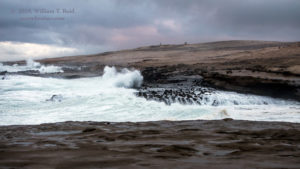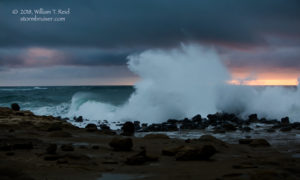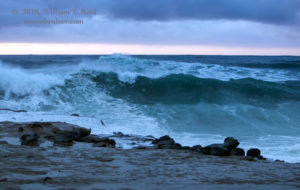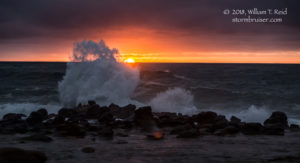The coast of Southern California faces mostly towards the south and southwest, so the large ocean swells of winter from the west and northwest, do not provide the heavy surf and large waves here compared to the Central California coast. Beaches that DO have a decent exposure towards the west might see the large swell dissipated greatly by offshore islands.
But, out at the western end of San Nicolas Island, these problems are moot! The west end of the island takes the full brunt of the large swells that are spawned by the deep and persistent storms in and around the Gulf of Alaska and across the northern Pacific Ocean. I suppose that I should add a caveat, however. There are apparently some shallows well offshore to the west of the island (a mile or two?) where waves break and the swell is diminished some before directly impacting the island.
December 17th was a Monday and a workday for me at the airport here on the island. Once at the airport around sunrise, a prominent and thunderous (though muted) roar was emanating from the northwest. This was due to giant surf! The eerie and continuous booming sound was the loudest that I had yet to hear in my off and on time during the previous four years here. The airport is towards the northeastern end of the island, and this giant surf was slamming the beaches about 3 to 6 miles distant to my northwest and west-northwest. I needed to be along the coast there NOW to photograph this event! But, I was stuck at work as the weather observer until 4 p.m. UGH. Would the heavy swells persist well into the afternoon? Why couldn’t these big waves had occurred during the weekend, when I was free?!
I went online and checked the buoy that is west of San Nicolas Island. By mid-morning, it was showing waves and/or swells over the open ocean waters that were averaging about 20 feet! That was up about 8-10 feet from the previous day, and up about 6 feet compared to 4 a.m., if my memory serves correctly. I still had to wait another 6 hours, though.
I had a hunch that the large swells would diminish some by the time my shift ended, and I was correct. These ultra-high wave events are usually fairly brief. By mid-afternoon, the buoy to the west (Buoy 46219) showed wave heights of about 15 to 16 feet. And, the thunderous roar was less than half as prominent as it had been. Shucks. My buddy picked me up at 4 p.m. and we headed first to the coastline near Thousand Springs, which has a perfect exposure towards the WNW (this is near the northern-most point of the island). The light was nice and the surf was impressive, and the photography was fun. It would have been nice to have been here at 8 a.m.! The first ten images below were from this location near Thousand Springs.
We decided to check out the surf at Rock Crusher before sunset. Rock Crusher has more of a westerly exposure, and the surf here seemed to be a little smaller comparably. However, the waves here crash directly into rocky cliff areas, which cause gigantic spray explosions! This was going to be cool, with the sun setting right behind! I had about ten minutes to shoot this scene before the sun set, and it was very worthwhile. The final 14 surf shots below are from Rock Crusher.



























Leave a Reply
You must be logged in to post a comment.